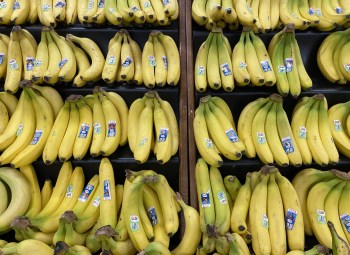Are mangoes the new banana?
Kai Ryssdal: There’s news of a tentative deal here in Southern California that’s going to avoid a strike at three major supermarket chains. It’ll keep more 60,000 workers on the job and stores open.
Next time you happen to be in a grocery store, take a swing by the produce section. Find the mangoes, give one a squeeze, take it home if you so choose, and ask yourself this: mangoes, have they always been here?
Lisa Matuska has more.
Lisa Matuska: Let’s start with the banana. In the early 1900s, the United Fruit Company transformed the banana. The company, now known as Chiquita, managed to turn this exotic yellow fruit into an international commodity with the help of railroads, politics and marketing.
Chris Rollins: If a banana isn’t nine inches, it’s garbage as far as Del Monte and Dole and Chiquita and all those big companies — that’s their standard. Now that’s really almost unnatural among bananas, they usually are smaller.
Chris Rollins is director of the Fruit and Spice Park in Homestead, Fla. He grows about 100 varieties of bananas in his park. He says it was only a few years ago that banana companies finally introduced a normal-sized banana.
Rollins: And the marketing was really funny because they implied that it was a genetic breakthrough they called it “the lunch box banana,” and in fact it was what bananas are.
Now let’s look at the mango. Its transformation began here — near Miami, at the Fairchild Botanical Gardens. In the 1950s and 1960s researchers brought in mangoes from around the world. They cross-bred the mangoes to develop new varieties.
Richard Campbell: They selected things that had red color, that had disease resistance, that shipped well, they could send them to New York and could get money for them, things like that. These were new ideas for mangoes.
Richard Campbell is a researcher at the gardens. And until the early ’90s most of the country’s mangoes were grown in Florida. But in 1992 Hurricane Andrew destroyed most of the state’s mango groves. In 1994 NAFTA was passed, which opened the floodgates for mango imports.
Campbell: And we started bringing in mangoes from Mexico, Guatemala, Nicaragua, Costa Rica, Brazil — and they were all our mangoes. They were all Florida varieties grown with Florida technology.
And now we get mangoes in grocery stores like this all across the U.S., all year round. But the fruit still has a long way to go in terms of a commodity. Fresh mangoes are still a little bit intimidating.
Consumers like Gail Miller are comfortable buying things like mango salsa or mango-flavored juice, but…
Matuska: You’ve never bought a mango in a grocery store?
Gail Miller: Never did. I wouldn’t know what to do with it, no, just peaches and the normal stuff.
This is where Wendy McManus comes in. She’s the director of marketing at the National Mango Board in Orlando.
Wendy McManus: It’s more of an impulse item, so that’s one of the big things that we try to work on. Just getting people to think about mangoes is kind of a huge thing, getting people just to even recognize what it is.
The mango board was formed in 2005 after a group of importers in Arizona decided that the mango should be the next big thing among fruit commodities. McManus says one of her major job duties is simply showing people how to cut a mango.
McManus: Some people call it the hedgehog, it’s where you cut off the cheek and you score both directions in a diamond pattern and then you turn the mango inside — out you sort of pop it out so the cubes are all sort of spiking out like a hedgehog.
If the hedgehog method is too confusing, she recommends just scooping it out with a spoon. But is that spoonful of mango tasty?
Campbell: We get a mango that’s pretty, it travels well, but doesn’t necessarily taste good.
Researcher Richard Campbell says that’s about to change. He says consumers are demanding new tastes, outside the generic. Take for example Indian mangoes…
Campbell: They are absolutely some of the most heavenly flavors on the planet, but an Indian mango can insult somebody. It can be so strong that if you’re not ready for it, it can really wake you up.
And Campbell says this wake up call is what’s next for mangoes. He’s talked with people from Costco, Walmart and Chiquita about branching out into new varieties. His team in South Florida has just patented their own variety that they hope to unleash on the market — it’s called the coconut cream mango.
For Marketplace, I’m Lisa Matuska.
There’s a lot happening in the world. Through it all, Marketplace is here for you.
You rely on Marketplace to break down the world’s events and tell you how it affects you in a fact-based, approachable way. We rely on your financial support to keep making that possible.
Your donation today powers the independent journalism that you rely on. For just $5/month, you can help sustain Marketplace so we can keep reporting on the things that matter to you.


















